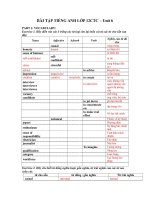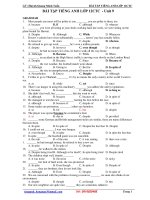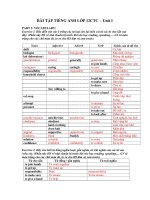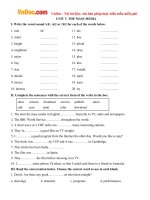BÀI TẬP TIẾNG ANH LỚP 12CTC - Unit 7 ppsx
Bạn đang xem bản rút gọn của tài liệu. Xem và tải ngay bản đầy đủ của tài liệu tại đây (5.48 MB, 7 trang )
BÀI TẬP TIẾNG ANH LỚP 12CTC - Unit 7
PART 1: VOCABULARY:
Exercise 1. Hãy điền vào các ô trống các từ loại còn lại (nếu có) từ các từ cho sẵn sau
đây:
Noun Adjective Adverb Verb Nghĩa của từ đã cho
economy
economic
economical
economically to economize
Nền kinh tế
reform
to reform
Sự cải cách
improvement
to improve
Cải thiện
promotion
To promote
Thăng tiến, thúc đẩy
To carry out
Thực hiện
Constant
constantly
Một cách thường xuyên
National Congress
Đại hội toàn quốc, Quốc hội
Communist Party
Đảng Cộng Sản
initiation initiative
To initiate
Khởi xướng
overall
Toàn diện
renovation
Sự đổi mới
To restructure
Xây dựng lại
Living standard
Mức sống
experience
To experience
Trải qua
To under-develop
Phát triển kém
domination dominative
To dominate
Thống trị
agriculture
agricultural
Nền nông nghiệp
stagnation
stagnant
To stagnate
Trì trệ
inflation
Sự lạm phát
To eleminate
Xóa bỏ
subsidies
To subsidize
Sự bao cấp
priority
Sự ưu tiên
To shift
Chuyển dịch
To reduce
Làm giảm, rút ngắn
intervention
Sự xen vào, sự can thiệp
Trade relation
Quan hệ thương mại
To encourage
Khuyến khích
domestic
Trong nước. nội địa
private
Tư nhân, riêng tư
investment
To invest
Sự đầu tư
Subsequent to
Tiếp theo, tiếp tục
commitment
To commit
Sự cam kết
To reaffirm
Khẳng định lại
To call for
Kêu gọi
administration
administrative
To administrate
Thuộc về quản lý
guidelines
Đường lối, nguyên tắc chỉ đạo
Land Law
Luật đất đai
Enterprises Law
Luật doanh nghiệp
Legal ground
Nền tảng pháp lý
dissolution dissolvant
To dissolve
Giải tán, phân hủy
Co-operatives
Hợp tác xã, sự hợp tác
to undergo
Trải qua
substantial
Quan trọng, trọng yếu
Land use rights
Quyền sử dụng đất
Ethnic minority
Dân tộc thiểu số
Those (Pron)
Người, Những ai
Exercise 2. Hãy cho biết từ đồng nghĩa hoặc gần nghĩa, từ trái nghĩa của các từ sau
(nếu có):
từ cho sẵn từ đồng / gần nghĩa
Từ trái nghĩa
A shortage of
A lack of
To eleminate
To delete, to cancel
To shift
To change
export
import
To encourage
To discourage
opportunity
chance
ineffective
effective
To increase
To rise, to go up To decrease, to reduce, to go down
achievement
accomplishment
rural
urban
(Từ Exercise 3 trở đi, GV có thể cho HS làm tại lớp, làm ở nhà để kiểm tra bài cũ hoặc
làm trong các tiết học tăng tiết. )
Exercise 3: Hãy chọn một câu trả lời đúng nhất:
1. Everybody should be made aware ________ the risks involved.
A. on B. in C. for D. of
2. The recent economic crisis has brought ________ a slump in world trade.
A. about B. in C. over F. out
3. The government is aiming ________ 50% reduction in unemployment.
A. to B. at C. on D. for
4. Sport is sometimes used by governments as a tool of foreign ________.
A. policy B. political C. politics D. politician
5. The President has ________ his commitment to the peace process.
A. reargued B. reenacted C. reaffirmed D. reminded
6. The government made serious attempts to raise the ________ of living.
A. standard B. cost C. level D. mode
7. The police have asked for the ________ of the public in tracing the whereabouts of
the escaped convict.
A. partnership B. co-operation C. association D. alliance
8. The government shifted economic priority from heavy industry to three major
economic programmes.
A. moved B. continued C. changed D. encouraged
9. The government introduced a wage freeze so that ________ might be brought under
control.
A. renovation B. economy C. inflation D.
development
10. A strike in the mining industry is threatening to bring about a shortage of coal in the
near future.
A. redundant B. ruin C. storage D. lack
11. The Vietnamese Communist Party ________ an overall economic reform in
December, 1986.
A. intimated B. initiated C. inherited D. inhaled
12. To promote the development of our country, we should ________ economic
reforms.
A. marry to B. bring about C. carry out D. take out
13. The aim of “Đổi Mới” was to ________ the economy of Vietnam and to raise the
living standards of the people.
A. restructure B. restroom C. restate D. remote
14. Before “Đổi Mới”, our country ________ a lot of difficulties on many aspects of
life.
A. expected B. experienced C. excepted D. extracted
15. Before “Đổi Mới”, our economy was ________ and was dominated by traditional
agriculture.
A. over-developing B. super-developing C. out-developed D. under-
developed
16. Before “Đổi Mới”, our country was ________ and the people led a /an ________
life.
A. rich / poor B. rich / stable C. poor / poor D. poor /
wealthy
17. Before “Đổi Mới”, there were ________ schools and hospitals.
A. a lack of B. an overdosage of C. sufficiency of D. abundance
of
18. It is quite important ________ me to get on and think.
A. of B. to C. on D. with
19. If you think you may be allergic to a food or drink, eliminate it ________ your diet.
A. for B. without C. from D. on
20. The new policies include cutting ________ subsidies and trade barriers.
A. agriculture B. agricultural C. agriculturalist D.
agriculturally
21. The control of ________ has been carried out through measures rooted in
monetarism.
A. inflate B. inflationist C. inflation D. inflator
22. It is often a good idea to start with small, easily ________ goals.
A. achieve B. achievement C. achievable D. achiever
23. Economic reforms began in the Soviet Union in June 1985 by the Soviet leader
Mikhail Gorbachev to ________ the Soviet economy.
A. repair B. reproduce C. restructure D. reply
24. After more than a decade of Doi Moi or economic ________ , the Vietnamese
Communist government has achieved diplomatic and economic links with numerous
foreign partners.
A. relation B. investment C. productivity D. renovation
25. For more than 20 years, the Vietnamese government has pursued the open-door
________ and continued to woo foreign investment.
A. policy B. way C. export D. guideline
26. After a decade of economic liberalization, Vietnam has seen a dramatic rise in living
________ in urban areas.
A. surface B. standards C. levels D.
backgrounds
27. ________ laws and regulations which impose restrictions on any rights should be
revised to comply with international law.
A. Domestic B. Program C. Encouraged D. Expanding
28. These new economic reforms have allowed for international ________ and
development in the country.
A. pay B. renovation C. investment D. opportunity
29. In 2001 ________ Vietnamese Communist Party approved a 10-year economic plan
that enhanced the role of the private sector while reaffirming the primacy of the state.
A. a B. an C. the D. Ø
30. It would also concomitantly attract foreign investment to Vietnam, not only from
____ U.S., but also from ________ Europe, Asia, and other regions.
A. Ø / the B. the / the C. Ø / an D. the / Ø
31. Economic reforms are often carried ________ to promote the developing of a
country.
A. out B. on C. for D. in
32. Being aware ________ the importance of economic reforms, the Vietnamese
Communist Party initiated an overall economic reform policy.
A. for B. at C. of D. in
33. For more than ten years, we have seen the significant ________ in the economy of
our country.
A. develop B. developments C. developers D. developed
34. Henry was a studious student. He needed no ________ to work hard.
A. encourage B. encouraging C. encouragement D. encouraged
35. During the time of economic reforms, the economy has grown ________ with only a
few major setbacks.
A. constant B. constantly C. constants D. constancy
36. The ________ effect of the new policy is that the farmer is now working for himself,
and not for the state sake.
A. legal B. common C. all D. overall
37. Considering peasants make up nearly 80% of Vietnam's population.
A. specialists B. economists C. professors D. farmers
38. The Doi Moi reforms have ________ new possibilities in farming systems research
in Vietnam.
A. risen B. opened C. renovated D. called
39. The introduction of appropriate farming practices to Vietnam farmers can help them
achieve a higher output.
A. productivity B. renovation C. guideline D.
achievement
40. This development project could be of great help to the ________ Vietnamese
population.
A. major B. living C. rural D. domestic
41. In the South, ________ development concentrated on rice cultivation, and
nationally, rice and rubber were the main items of export.
A. industrial B. agricultural C. mining D. textile
42. There was a shortage ________ food and safe water after the flooD.
A. on B. with C. for D. of
43. The new measures are aimed ________ increasing the productivity of crops.
A. at B. over C. upon D. beyond
44. The ________ challenge of economic, reform was to solve the problems of
motivating workers and farmers to produce a larger surplus.
A. initial B. initiate C. initiative D. initiation
45. Since 1990, India has had high growth rates, and has emerged as one of the
wealthiest ________ in the developing worlD.
A. economics B. economies C. economists D.
economically
46. Those specialists are trying to find ways of making more ________ use of
agricultural lanD.
A. produce B. production C. productive D.
productivity
47. Industry in the area consisted mostly of food-processing plants and factories
________ consumer goods.
A. renovating B. initiating C. developing D. producing
48. The government gave top ________ to reforming the legal system.
A. priority B. primary C. preference D. major
49. A ________ is money that is paid by a government or other authority in order to
help an industry or business, or to pay for a public service.
A. capital B. subsidy C. investment D. salary
50. They still remain the need for an integrated system of subsidies which will
________ farmers to look after their upland environment and producing fooD.
A. enable B. adopt C. consume D. expand
51. Development plans were to focus equally on agriculture and industry and investment
was to favor projects that developed both ________ of the economy.
A. parties B. parts C. sections D. sectors
52. Despite the plan's emphasis on agricultural ________ , the industrial sector received
a larger share of state investment.
A. shortage B. commitment C. development D.
achievement
53. Before “Đổi Mới”, the production of pur country was ________.
A. developing B. stagnant C. prosperous D. stable
54. To solve the problems before Đổi Mới, our Government introduced a number of
________ measures.
A. renovation B. remember C. résumé D. resolution
55. Since Đổi Mới, our country has undergone ________ changes in many branches of
life.
A. subsidy B. submarin C. substitute D. substantial
56. “________” means “an economic process in which prices increase so that money
becomes less valuable.”
A. Renovation B. Reform C. Inflation D.
Intervention
57. As a result of the strike, the government is urging people to be ________ with
electricity.
A. economical B. economy C. economic D.
economically
58. The reform has brought ________ positive effects in many sectors of the economy.
A. in B. about C. on D. to
59. It is ________ to shoot an alligator in the Everglades where animals are under the
protection of the National Park Service.
A. legal B. illegal C. legally D. illegality
60. The government cut spending through reductions in state ________ to industry.
A. benefit B. subsidies C. intervention D. taxes
61. The government is aiming ________ 50% reduction ________ unemployment.
A. at/ in B. to/ in C. at/ of D. for/ of
62. After many years of Doi Moi process, Vietnam has ________ many encouraging
results.
A. achieve B. achieved C. achieves D. achieving
63. Did your country ________ a lot of difficulties before Doi Moi?
A. experience B. experienced C. experiences D.
experiencing
64. I want you to ________ these instructions exactly.
A. take up B. put out C. turn up D. carry out
65. The committee ________ among themselves for hours.
A. have been arguing B. have been argued C. has been arguing D. has been
argued
66. Industrial countries ________ a great amount of raw materials.
A. absorb B. apply C. employ D. consume.
67. The most important impact of ________ is the change in urban economic life.
A. renew B. renovation C. recycle D. change
68. We need a ________ improvement in sales so that they are greater.
A. greatly B. economic C. substantial D. particularly
69. Don’t you think the manager should deal ________ this problem?
A. with B. to C. on D. from
70. You have to work hard to keep ________ with the rest of the class.
A. out B. up C. in D. on
71. Being aware ________ the importance of economic reforms, the Vietnamese
Communist Party initiated an overall economic reform policy.
A. for B. at C. of D. in
72. This development project could be of great help to the ________ Vietnamese
population.
A. major B. living C. rural D. domestic
73.
The
authorities are determined to take together
________
to reduce crime.
A. situations
B. measures
C. requirements D. interests
74.
T
h
e old theater is in need of complete
________.
A. renew B. rebuild
C. renovation
D. review
75.
Prior to the economic reform, the country had experienced many years of a
________
economy.
A. stagnant
B. fluent C. fluently D. smoothly
76.
Education is our first
________
now. We are trying to do what we can to make
it better.
A. prior B. prioritization C. priory
D. priority
77.
They have made a substantial change; that means, they have made a(n)
________
change.
A. economic
B. considerable
C. steady D. subtle
78.
M.D. played much better than their opponents; they almost
________
the
match.
A. dominated
B. eliminated C. activated D. terminated
79.
The company was
________
because of a shortage of orders.
A. solved B. resolved
C. dissolved
D. involved
80. With the tactful guidelines of the Vietnamese Communist Party, we have ________
to wish to live a brighter life.
A. wrongdoings B. corrects C. truths
D. rights
Since the introduction of economic reforms in India in early 1990s, the major thrust of
the country has been to achieve faster economic (1)________, higher export earnings,
greater foreign reserves, and enhanced foreign direct investment. (2)________ efforts
have been directed towards achieving the desired goals in these macro-economic
parameters. (3)________ it is heartening to note the accomplishments at the macro-
economic front, it is (4)________ disturbing that the enhanced rate of economic growth
has failed to address certain issues of vital importance. These issues and concerns include
the dynamics of labor marker, progress (5)________ the agricultural sector, gender
equality, caste representations, cultural development, and environmental protection.
1. A. grew B. growing C. growth D. grows
2. A. Wide B. Big C. Enormous D. Large
3. A. With B. While C. By D. When
4. A. equation B. equal C. equality D. equally
5. A. of B. on C. with D. at









